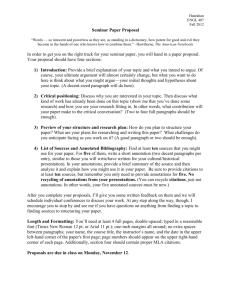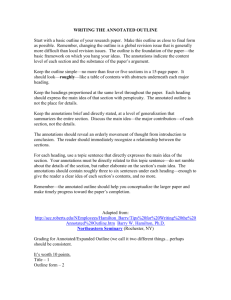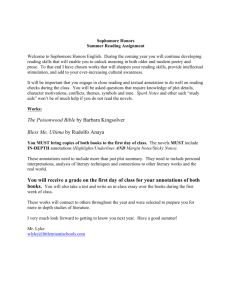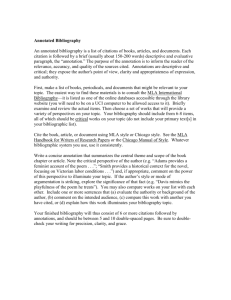Annotated List of Works Consulted Hold the shift key while dragging
advertisement
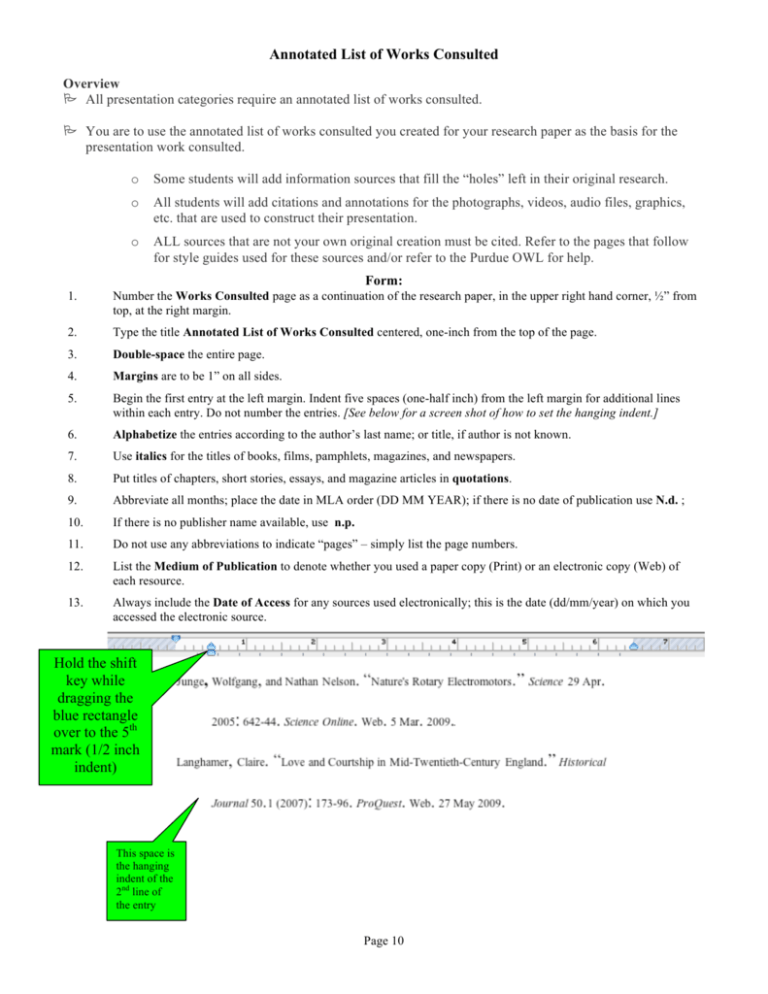
Annotated List of Works Consulted Overview P All presentation categories require an annotated list of works consulted. P You are to use the annotated list of works consulted you created for your research paper as the basis for the presentation work consulted. o Some students will add information sources that fill the “holes” left in their original research. o All students will add citations and annotations for the photographs, videos, audio files, graphics, etc. that are used to construct their presentation. o ALL sources that are not your own original creation must be cited. Refer to the pages that follow for style guides used for these sources and/or refer to the Purdue OWL for help. Form: 1. Number the Works Consulted page as a continuation of the research paper, in the upper right hand corner, ½” from top, at the right margin. 2. Type the title Annotated List of Works Consulted centered, one-inch from the top of the page. 3. Double-space the entire page. 4. Margins are to be 1” on all sides. 5. Begin the first entry at the left margin. Indent five spaces (one-half inch) from the left margin for additional lines within each entry. Do not number the entries. [See below for a screen shot of how to set the hanging indent.] 6. Alphabetize the entries according to the author’s last name; or title, if author is not known. 7. Use italics for the titles of books, films, pamphlets, magazines, and newspapers. 8. Put titles of chapters, short stories, essays, and magazine articles in quotations. 9. Abbreviate all months; place the date in MLA order (DD MM YEAR); if there is no date of publication use N.d. ; 10. If there is no publisher name available, use n.p. 11. Do not use any abbreviations to indicate “pages” – simply list the page numbers. 12. List the Medium of Publication to denote whether you used a paper copy (Print) or an electronic copy (Web) of each resource. 13. Always include the Date of Access for any sources used electronically; this is the date (dd/mm/year) on which you accessed the electronic source. Hold the shift key while dragging the blue rectangle over to the 5th mark (1/2 inch indent) This space is the hanging indent of the 2nd line of the entry Page 10 Name ____________________________ Period _______ Order # ____ Annotated List of Works Consulted Rubric ___ Annotations/Clarity 3 – Annotations are clear. 2.5 – Annotations are developing toward clear. 2 – Annotations are insufficiently clear. 0 – Annotations are grossly unclear. ___ Annotations/Conciseness 3 – Annotations are concise. 2.5 – Annotations are developing toward concise. 2 – Annotations are insufficiently concise. 0 – Annotations are grossly less than concise. ___ Annotations/Informative 3 – Annotations are informative. 2.5 – Annotations are developing toward informative. 2 – Annotations are insufficiently informative. 0 – No annotations are grossly uninformative. ___ Citations in MLA 6 - All citations are properly arranged in MLA format. 5.1 - Most citations are properly arranged in MLA format. 4.2 - Few citations are properly arranged in MLA format. 0 - No citations are properly arranged in MLA format. General Formatting ___/1 One-inch margins ___/2 Titled “List of Annotated Works Consulted” and centered/underlined ___/2 Running header continues from previous section (Process Paper) ___/2 Double-spaced w/no extra spacing between entries ___ Sections 2 – Citations are accurately separated into “Primary Source” and “Secondary Source” sections 1 – Most citations are accurately separated into “Primary Source” and “Secondary Source” sections 0 – Citations are not separated into “Primary Source” and “Secondary Source” sections; or grossly inadequately done so. ___ Alphabetized 2 - All citations are alphabetized properly. 1 – Most citations are alphabetized properly 0 - Citations are not alphabetized properly. ___ Indented 2 - All citations use the proper hanging-indent. 1 – Most citations use the proper hanging-indent 0 - Citations are do not use the hanging indent Additional Comments for revision: Raw Points = ______/28 pts = ______% x 20 pts = ______ Page 11 MLA Citation Guide for A/V Sources You should also refer to the Research Manual for previously taught citations (books, web sources, journal articles, etc) National History Day MLA 7th ed. citation info. Miscellaneous sources Digital music files (.mp3, .aac, .aif, .mpa, .wav, .wma etc.) Use as many of the following as you can (in the following order) in your citation: 1. Name of performer or composer 2. Title of the song (italicized if the work is independent, quotation marks if the work is part of larger work) 3. Title of the overall work (italicized) (if applicable) 4. Name of the publisher or record company 5. Year of publication 6. Medium of publication (if none is specified, use the words Digital file) 7. Date of access (if the audio is part of or plays from a Web page) Example 1 Hudson, Jennifer. “And I Am Telling You I’m not Going.” Dreamgirls: Music from the Motion Picture. author song title overall work title - italics Sony BMG, 2006. MP3 file. publisher date published medium of publication Example 2 Jones, Norah. "Light as a Feather." The Fall. Blue Note Records, 2009. MP3 file. author song title overall work title - italics publisher date published medium of publication Digital Video Files (.avi, .flv, .f4v, .mov, .mp4, .mpg, .rm etc.) Use as many of the following as you can (in the following order) in your citation: 1. 2. 3. 4. 5. 6. Author's Last Name, First Name OR Corporate/Institutional Author Name (if available) Title video file Document date OR date of last revision Medium (e.g. Online video clip) Title of larger web site in which clip is located Access Date Example 1 Lucasfilm, Ltd. "Star Wars Trailer." 5 Nov. 1999. Online video clip. Star Wars Official Site. 2 Apr. 2010. author or institution video title date published medium of publication publisher or website URL stem - italics access date Example 2 "Daughter Turns Dad In." 1 Apr. 2008. CNN Video. Online video clip. CNN.com. 4 Apr. 2008. Page 12 An Image (a Photograph or Clipart Image from online source) Use as many of the following as you can (in the following order) in your citation: 1. 2. 3. 4. 5. 6. 7. Artist’s name w/ surname first (if available) Title OR description OR file name (jpg or gif) (in quotation marks) Author of website (if available) Title of Web site home page (italicized) (if available) Database name (italicized) (if available) URL stem of image Date of access Example 1 Schulz, Charles. "Snoopy Cuddling Woodstock." The Art Store. Art.com. 25 Apr. 2004. artist or photographer title publisher website URL stem - italics access date Example 2 “Lent.” Clipart For Schools. downloads.clipart.com. 12 Feb. 2010. Digital Data Files [.pdf, .doc(x), .ppt(x), .xml, .xls(x) etc.] 1. 2. 3. 4. 5. 6. Name of the author, editor, compiler, or translator Title of work (italicized if the work is independent, quotation marks if the work is part of larger work) Edition used (if applicable) Number of volume used (if applicable) City of publication, name of publisher, and year of publication Medium of publication (use the name of the digital format followed by the word file. If no medium is specified, use the words Digital file. Titles of software programs are italicized. 7. Date of access. Example 1 Smith, George. “Pax Americana: Strife in a Time of Peace.” 2005. Microsoft Word file. 4 Dec. 2009. author year of publication file title medium of publication - italics access date Example 2 Smith, John. “Growing an Avocado Plant at Home.” 2003. Microsoft PowerPoint file. 23 Jun. 2008 Example 3 Bentley, Phyllis. “Yorkshire and the Novelist.” The Kenyon Review 30.4 (1968): 509-22. JSTOR. PDF file. 1 Mar. 2007 Page 13
